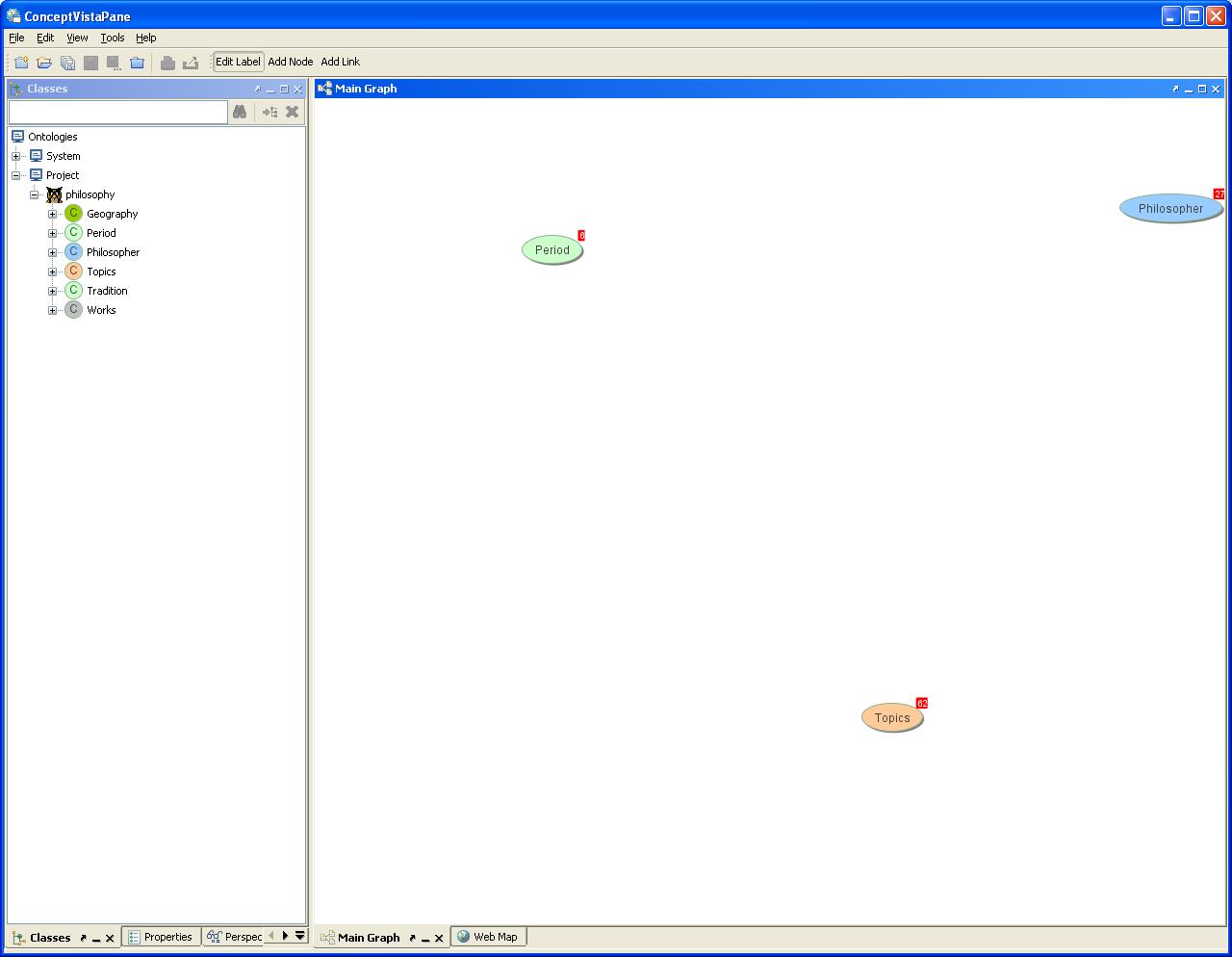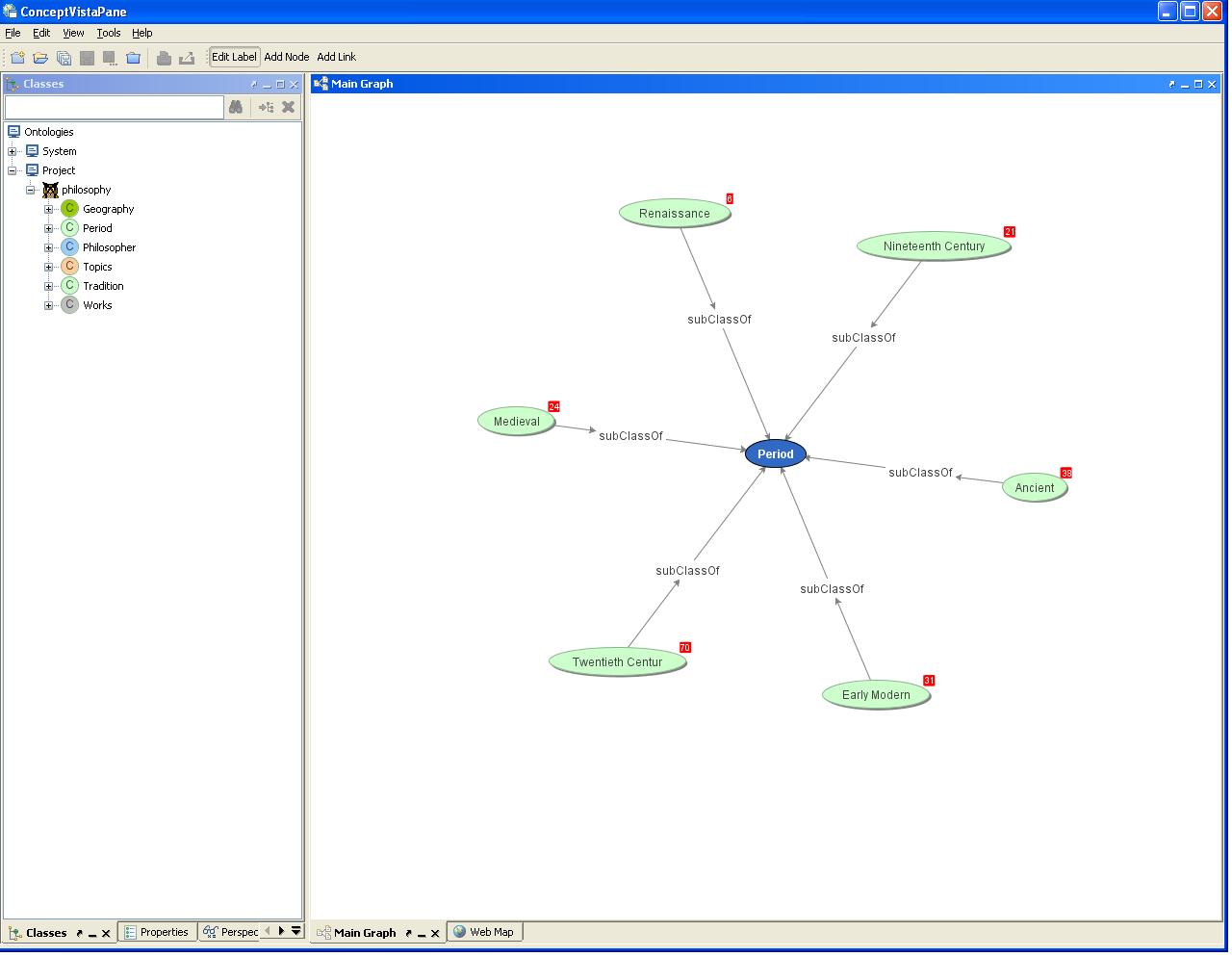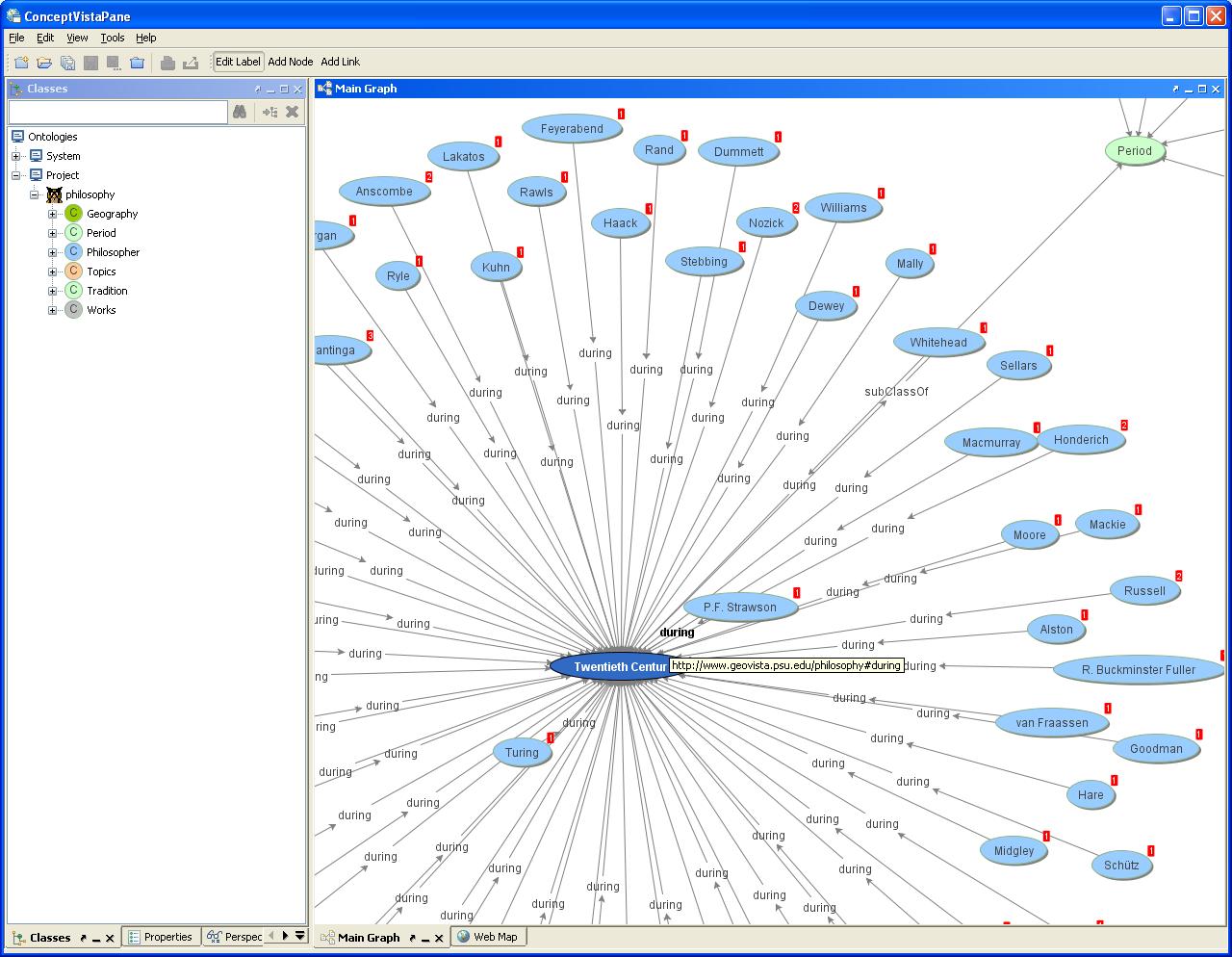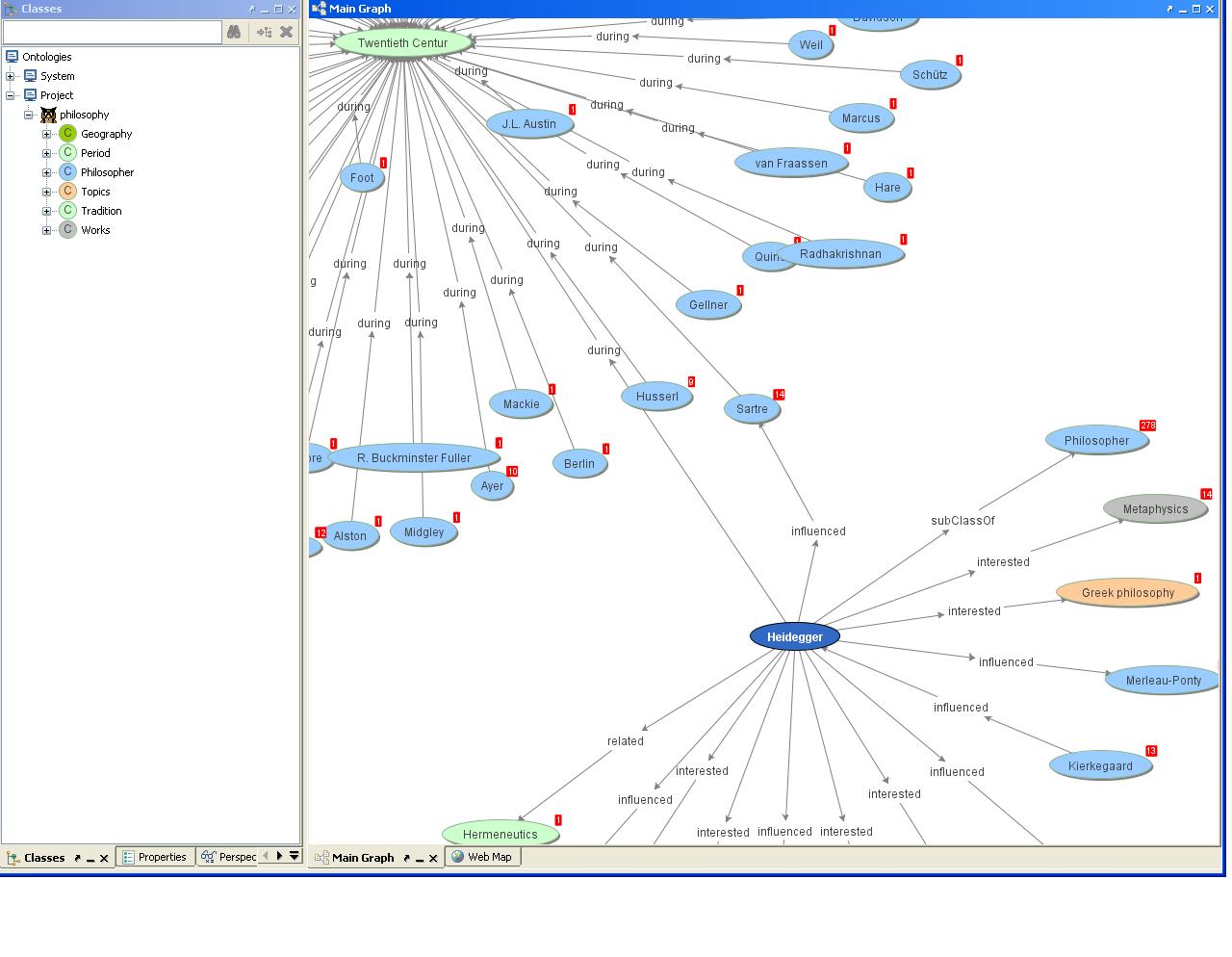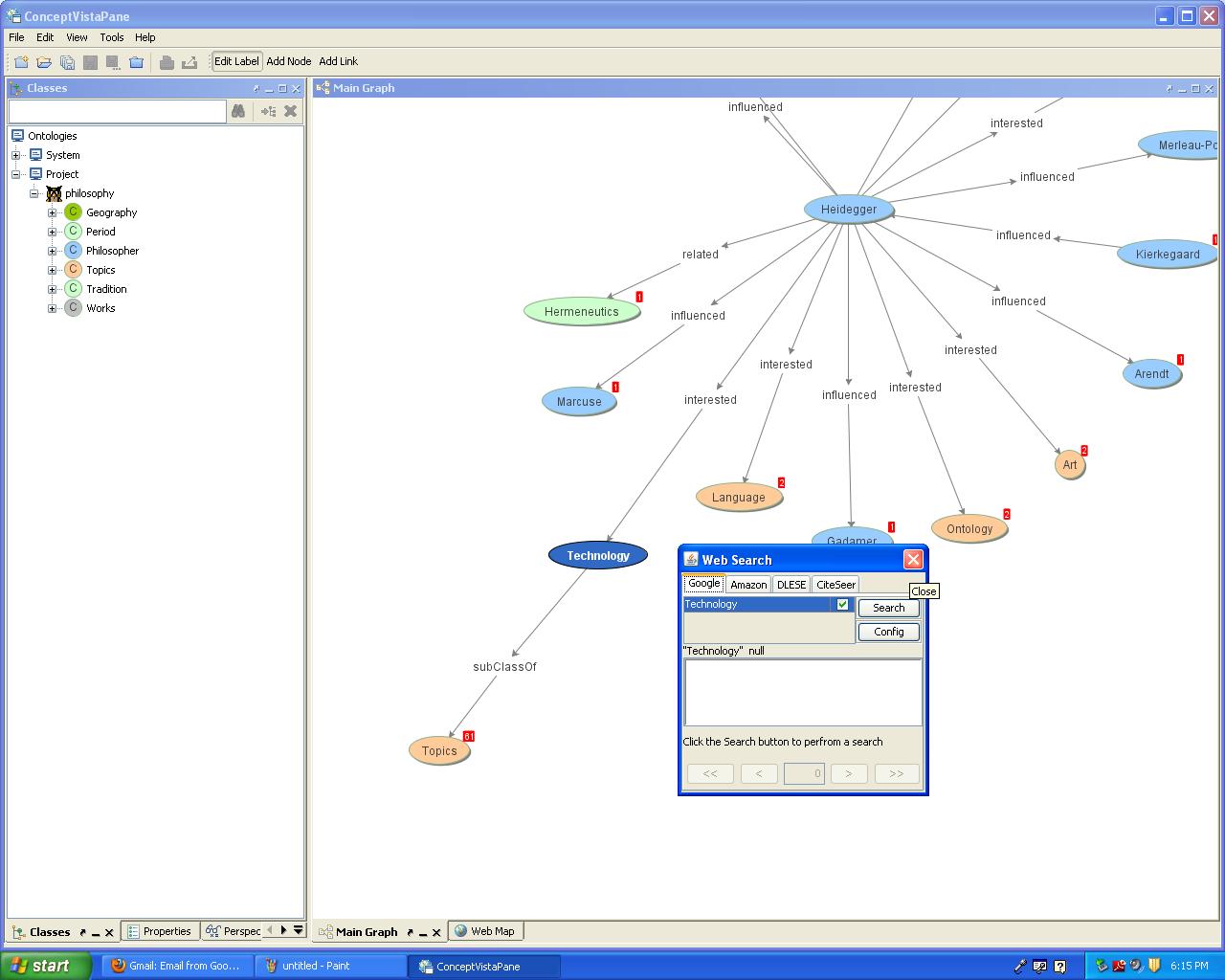Related Categories: Research-Oriented Social Environment | Alternative Interfaces | Related Projects & Centers
Summary
ConceptVISTA is a free software created through the collaboration of researchers at the Geographic Visualization Science, Technology and Applications Center (GeoVISTA) at the University of Pennsylvania, the University of Southampton, University of Leeds, and UC Santa Barbara. Using the priniciples of the semantic web, ConceptVISTA is a browser for mapping of concepts, teaching objects, and their related contexts in a way that “allows users to define and link concepts and resources pertaining to a conceptual domain.”1 It is designed to provide a rigorous user-based environment that allows users to add, view, and manage information and related to concepts and resources, primarily for pedagogical purposes through a web browser. Using the Web Ontology Langauge (OWL)2, it is based on the semantic web, and can also be used to import and organize outside ontologies.
Description
More than just a visualization tool, ConceptVISTA uses the ideals of the semantic web to enable users (primarily educators) to find, share, and combine information across geographically dispersed institutions and departments. Combined with other software programs, like the Learning Design Toolkit from the DialogPLUS project, ConceptVISTA forms part of a larger teaching and learning environment. It was initially designed to offer broad browser-based web research and sharing tools. According to an article published in the International Journal of Digital Libraries, the researchers for the project describe ConceptVISTA as a “concept mapping tool enhanced with web browsing, ontological reasoning, search engines, event logging and concept comparison methods.”3 Utilizing computational ontologies, distinct from philosophical ontologies which offer more metaphysical explanations, ConceptVISTA gives users the opportunity to create their own models of knowledge that do not require previously established models of information. Learning objects and educational content can be semantically related to or against other items and terms to create the language to describe concepts and their appropriate disciplinary contexts.
In addition to the visual mapping, ConceptVISTA links visualizations with media resources while also allowing users to add resources and search for others. Web browsing and search capabilities can be found within each visualization and can be used in relation to specific nodes.
For the sake of expediency, this report will look at an imported ontology, “Philosophy,” from the Learning Design Toolkit, offered among several sample ontologies from the ConceptVISTA homepage. These imported ontologies are downloaded as zip files and must be decompressed into .CVX files within the ConceptVISTA folders.
Upon opening the “philosophy.cvx” a fairly blank map appears in the “Main Graph” window to the right. Six disparate nodes or colored ovals float in the space, each appearing to push away from the next. Each node corresponds to one of the six categories in the “Classes” outline window on the left: “Geography” (19), “Period” (6), “Philosopher” (279), “Tradition” (30), “Works” (68), and “Topics” (62). The numbers in parentheses here correspond to more granular objects located within that category (for example, there are 279 individual philosophers listed in this specific ontology, corresponding to six different historical periods, and thirty different theoretical traditions, etc.). These granular objects can also include teaching materials, websites, or documents that are linked to that topic. These external objects do not appear in this specific ontology.
Each one of these large nodes can be expanded to reveal more specific information categorized as subclasses of that node. For example, double clicking or right clicking and then choosing “Expand” from the menu on the “Period” node leads to a larger map of six different historical time periods (e.g. Ancient, Medieval, Renaissance, etc.) with superscript numbers indicating the number of objects further organized into subclasses are within each period. The vectors connecting the individual time period node denote that the specific time period is a “subclass” of the larger “Period” node.
Expanding the Twentieth Century node reveals seventy-one philosophers and theorists who were active within that contemporary time period.
Clicking on the node for Heidegger leads to another map of his own visualization of related philosophers, traditions, works, topics, etc., which are all color coded. The light blue nodes represent individual philosophers, light purple nodes refer to the branch of philosophy to which that person is associated, light green corresponds to the time period, and so on. In this particular screen shot, we can see that Heidegger was active during the Twentieth Century, was influenced by Sartre and Kierkegaard, was interested in Greek Philosophy, is related to hermeneutics, etc.
Finally, if a researcher using this ontology wanted to find more information on Heidegger after this visual search, she or he can utilize the web search tools built into the ConceptVISTA system. By right-clicking on a node, and then can choosing “Web Search” from the menu a small window will appear on top of the map that gives the user several search options through the multiple tabs: Google, Amazon, DLESE (Digital Library for Earth System Education), and CiteSeer (Scientific Literature Digital Library and Search Engine, which is now in Beta development).
At the time that this was tested, the Google search was broken because of html upgrades to the Google search engine that had broken with the original coding of ConceptVISTA. The Amazon search was also limited, and search results were no more specific or helpful than searching on Amazon’s own site. The DLESE and the CiteSeer searches are more robust, but also more limited as they draw from databases for earth science related areas of study.
Research Context
Unlike other disciplinary-specific projects, ConceptVISTA attempts to be a system that can address the needs of users in any field. Though originally made for social and hard science (namely geographic information science) audiences with a specialized knowledge of RDF and OWL vocabularies, it shows a large degree of flexibility and portability in that new research-specific ontologies can be created for any field without being dependent on information already existing in the program or related system. In addition, technical knowledge of the OWL and RDF languages, though helpful, is not necessary to use the program. One of ConceptVISTA’s strengths comes in the specificity and granularity of information that can be created and associated within each individual ontology and then with each hierarchy and node (whether that be a person, a location, a time, etc.). In particular, relationship types between nodes (e.g. influenced by, subclass of, during, etc.) are customizable and can vary according to need in that discipline. Each visualization also can be modified in terms of visual components (shapes of nodes, colors, views, etc.) depending on need and desire.
That said, there are several things that make it unlikely that ConceptVISTA would be adopted by people outside of the earth sciences, or even within it. A major drawback with ConceptVISTA is that creating one of these ontologies is incredibly labor intensive and requires a lot of training and/or practice to create a detailed enough map with varied relationships, learning and teaching tools, resources, sites, etc. that would make it useful to others. In most cases if an ontology were to be built from scratch that would require much work in a program that is still quite buggy. One can also import an existing sample ontology and build off of it, but that might present additional problems if there are proprietary concerns. The software may be free, but the users are not yet networked or linked to one another in an open environment that fosters sharing and collaboration.
An additional problem that can be fixed but can also be difficult in terms of maintenance issues is with the limited search capabilities. Aside from the present bugs due to coding issues, the variety of search engines is also very limited and exclusionary. At this time there are two scholarly search functions to databases in the geographic and hard sciences. The generic Amazon and Google searches are not very robust in terms of scholarly and peer-reviewed materials (nor are they both functioning), and this makes ConceptVISTA more exclusionary terms of who would benefit from and want to use it. The sample exploration of a philosophical ontology report showed that none of the search tools were productive in yielding reliable resources for Heidegger or Kierkegaard.
Ultimately, the capability is there for visualizing maps for various canons of knowledge and connecting those maps to additional resources, but the desire to be inclusive of all disciplines actually results in a tool that is not quite fully formed nor useful for a large portion of educators or academics.
Technical Analysis
ConceptVISTA is browser-based visualization and mapping program individually constructed ontologies. It does not open in an existing browser (Firefox, Internet Explorer, Safari, etc.), but instead utilized what is called the “ConceptViewPane” in which each ontology is displated in multiple windows to view the maps, classes, perspectives, etc. which each appear in different windows. It is Java based, with the most recent alpha version 4.0 requires Javaâ„¢ 1.6 or higher and is only operable on Windows machines that have Java Web Start. The standalone Java installer comes bundled with Sun Javaâ„¢ JRE 1.6_10. It stores and imports RDF (Research Description Framework)/OWL (Web Ontology Language) vocabularies, which largely standardized, though these specific file formats cannot otherwise be opened and read by other programs. OWL, a form of XML (extensional Markup Language), is employed to give users the ability to customize tags for their web content and is designed to be a visualization tool to let educators map concepts that are easily machine read and processed, and has greater machine interpretability than regular XML, RDF, or RDF-S. This also provides more options for vocabulary along with formal semantics. OWL has three sublanguages with differing degrees of expressivity: OWL Lite, OWL DL, and OWL Full. Source code for ConceptVISTA is open source and available for redistribution and modification: http://conceptvista.sourceforge.net/
It must be noted that the platform includes software that must be downloaded and run using a Java program, Java Web Start, available only on Windows machines. Sample ontologies can also be downloaded from the ConceptVISTA site, and new ones can be created, though in this respect ConceptVISTA is not entirely intuitive nor without its technical bugs. Ontologies must be saved in a special file type of either .cvx or .owl.
Evaluation of Opportunities and Limitations for RoSE
ConceptVISTA has garnered much attention in the field of Geographic Information Studies (GIS) as a possible viable platform for information visualization and management. ConceptVISTA also demonstrates a great potential to be imported to many other disciplines and fields of study, because it does not require any previously existing ontological language, and each ontology can have its own individually defined classes and subclasses. This flexibility may also be its largest weakness. The program does not store any information and any labels, relationships, resources, etc. must instead be inputted by the user. In order for it to be more useful on a larger scale, especially to disperse and share information as planned by the original literatures, it would require a database that can store the information, resources, and ontologies in a way that they can be accessed and edited from multiple points. As it is now, the program must be downloaded onto individual computers and ontologies are saved in static form to be downloaded and opened, or to be created and saved by individuals, but they are not yet networked. In addition, the labor and time investment needed to create new ontologies can also act as a barrier for entry.
In these respects, RoSE shows an advantage over ConceptVISTA, even if its user-base is more limited and specific. The discipline-specificity of RoSE allows the designers to more strategically design the program to serve the needs of literary and cultural scholars, educators, and students. Since RoSE draws information from several sources to build an extensive database of bibliographic and biographic information, it provides an existing source from which users can make personalized networks of texts and contexts. This produces a very low he barrier to entry for new users as they do not need to invest extraordinary amounts of labor nor do they need to have any special technical knowledge. Additionally, the capacity for users to add information (e.g. texts, contexts, etc.) for objects and people not already in the system opens up the user-base to include scholars and students studying texts outside of canonical fields that would be found in Project Gutenberg or Yago, where are information is mined from.
The built-in social network model of RoSE that asks users to create profiles, and then embeds them into the RoSE database allows users to situate themselves in relation to their objects of study and other people. This privileges a less hierarchical approach to mapping out contexts (no classes and subclasses). The diversity of the relationship types in RoSE is also quite broad, though users cannot create new relationship types, which is one of the major attractions of ConceptVISTA. Like ConceptVISTA, though, users can make their own maps or contexts through individual acts of relating people to documents, people to people, and documents to documents. Depending on future implementation of algorithms, RoSE may eventually be able to depict emergent relationships or suggest people and documents that are initially outside of user’s immediate view to further assist educators in forming pedagogical materials, and scholars in finding related materials for research projects. ConceptVISTA, on the other hand, does not have the built in capacity to view emergent relationships since it is reliant on data inputted by the user.
Further Reading
Mark Gahegan, Ritesh Agrawal, Tawan Banchuen and David DiBiase. “Building rich, semantic descriptions of learning activities to facilitate reuse in digital libraries.” International Journal on Digital Libraries”, Vol. 7, Nos. 1-2, October 2007, pp. 81-97. [PDF].
Mark Gahegan, Ritesh Agrawal, Anuj Jaiswal, Junyan Luo and Kean-Huat Soon. “A platform for experimenting with measures of semantic similarity and supporting individual perspectives onto shared ontologies.” Transactions in GIS. [PDF] (Under Review).
“Semantic web.” W3. 2010. http://www.w3.org/standards/semanticweb/
Notes
1 http://www.geovista.psu.edu/ConceptVISTA/index.jsp
2 http://www.w3.org/TR/owl-features/
3 Mark Gahegan, Ritesh Agrawal, Tawan Banchuen and David DiBiase. “Building rich, semantic descriptions of learning activities to facilitate reuse in digital libraries.”International Journal on Digital Libraries”, Vol. 7, Nos. 1-2, October 2007, pp. 81-97.

